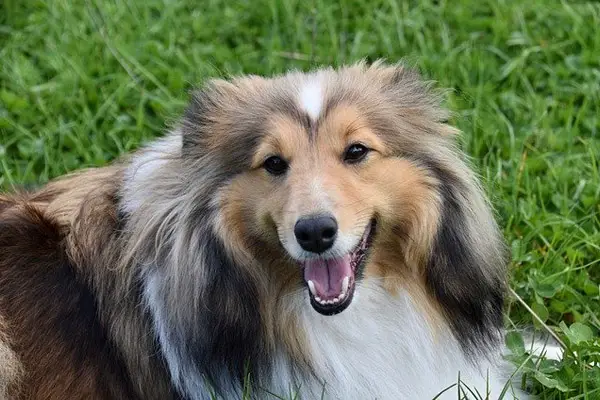Shetland Sheepdogs, or Shelties, are small-sized and active dogs. They were initially bred as herding dogs, and they are referred to as Scottish farmers’ best friends. The Shetland Sheepdog looks like smaller versions of the Collie dog and only grows up to 16 inches. They feature a long, straight coat that serves to protect them in harsh weather conditions. They have wedge-shaped heads and erect ears.
Shetland Sheepdogs are also known for their intelligence. They have world-class skills in obedience, herding, and agility training. They are excellent family dogs too, and despite their herding dog background, they will do well in an apartment environment. They are also perfect companions for those who are working as these dogs don’t mind being left at home alone.

Shetland Sheepdog Statistics
| Dog Breed Group | Herding |
| Breed Size | Small |
| Height | 13-16 inches |
| Weight | 12-25 pounds |
| Lifespan | 12-14 years |
Shetland Sheepdog Ratings
| Energy level | |
| Exercise needs | |
| Requires attention | |
| Playfulness | |
| Trainability | |
| Shedding | |
| Grooming | |
| Friendly with family | |
| Friendly with kids | |
| Friendly with strangers | |
| Friendly with other dogs | |
| Prey Drive |
Shetland Sheepdog History
Shetland Sheepdogs came from the Shetland Islands of Scotland, which is at the northernmost point of the United Kingdom. Shetland Sheepdogs are mainly herding dogs to protect Shetland Sheeps from birds. They were originally called Toonie, which is a Norwegian word for farm.
Because of the area’s harsh conditions, Shetland Sheepdogs were bred smaller than their larger cousins, the Collies. This is so they would eat little as vegetation is sparse. There was no record, though, as to when and how the dog breed’s size was reduced.
However, it was believed that in the 1800s, Shetland farmers started breeding the Sheltie to become smaller and fluffier so they could sell them to island tourists. However, too much breeding almost caused the original breed to disappear. They struggled on breeding the Shetland Sheepdogs back to how they initially looked. And during these times, the Shelties were unknown to the rest of Britain.
It was only until the early 20th century when Shetland Sheepdogs entered the dog shows. And in 1909, England’s Kennel Club finally recognized the dog breed and registered 28 of the dog breed. They were originally called Shetland Collie. However, due to some debate, the name was changed to Shetland Sheepdog.
In 1911, the American Kennel Club finally recognized the breed. At the same time, it was settled that the standard appearance of the Shetland Sheepdog should resemble a Collie in a smaller size.
By the 1970s, the Shetland Sheepdog’s popularity soared up high and was ranked as one of the most popular dog breeds in the US, until now.

Shetland Sheepdog Temperament
Shetland Sheepdogs are generally playful, energetic, and bright, which is common in herding dogs. They are described as agile and graceful jumpers. And since they are highly active, they require more exercise than any other small dog breeds. In other words, you can’t expect them to stay still.
Their sweet, soft, and pleasing personality are what made them popular family dogs. They are not clingy dogs, which makes them perfect companions for those who work and are out most of the time. They are fine being left alone; however, be sure to give them enough attention once you’re home.
If you have other pets, then that’s not a problem as Shetland Sheepdogs are generally peaceful with other animals. They are also reserved and timid when it comes to strangers. They are alert and will stay on guard, which makes them excellent watchdogs.
Generally, there isn’t a problem with having a Shetland Sheepdog at home. However, if there’s one thing you need to take note of, it’s that they are overly reactive to loud noises. You also need to supervise them and don’t leave them alone with your children. They are easily startled, and some mannerisms of small children can be a trigger.
Training and early socialization are needed to ensure proper behavior. And since these dogs are highly attentive and responsive, it’s easy to train them. Just make sure you retain calmness and gentleness.
Never guide them with harshness as they are pretty sensitive. Praise them and give them treats if they do well – this always works.
Shetland Sheepdog Care Requirements
- Nutrition: Just like any highly active dog, Shetland Sheepdogs need a nutritious diet with high-quality ingredients only. Daily calorie intake is something that you need to monitor. Be careful not to overfeed them. You can feed Shetland Sheepdogs dry food or home-cooked meals. Just remember that if you’re opting for commercial food products, it should not contain fillers and by-products. These don’t offer any nutritional value. You should also make sure that the first ingredient should not be grain, wheat, or corn. It should always be meat. Opting for home-cooked foods is safer, and Shetland Sheepdogs mostly love this. The main ingredient should always be animal protein, and they can get this from turkey, fish, chicken, beef, or lamb. You can also add cooked rice and vegetables for additional nutrition. You can also give treats if you want, especially if you’re training him. However, don’t forget the calorie of the treats as well and include this in your daily calorie count.
- Grooming: The Shetland Sheepdog’s double coat shed seasonally. However, brushing the fur should be done weekly (more often during the shedding season) if you want to maintain its healthiness. This will also help reduce the amount of shedding when shedding season comes. It’s essential to check for matted fur behind the ears, under the elbow on the front of each leg, and under the tail. You can trim the coat if it gets too long, however, never shave a Shetland Sheepdog. Their fur is designed to protect them from harsh weather conditions, and that includes overheating or overcooking. Baths should be occasional, depending on how dirty he gets. His activities can be a factor for this. Also, don’t forget to check and trim the nails always. If it gets too long, this might cause your dog pain. Added to that, clean up the ears as well.
- Exercise: Shetland Sheepdogs are highly active dogs that need moderate but regular exercise. You can’t expect them to stay still, so training is something you would need to offer. A 30-60 minute walk twice a day will do. They’re thinkers as well, which is why they also need mental stimulation. You can consider giving them activities that will test their agility, obedience, and herding skills. Fetch and ball chasing are two activities he will highly enjoy.
- Health: Shetland Sheepdogs are generally healthy; however, they are still prone to some health conditions you should be aware of. Collie Eye Anomaly is the number one condition most common to the breed. This is when parts of the eye have a malformation and might cause blindness. Other serious conditions also include progressive retinal atrophy and transitional cell carcinoma. Other common health conditions are hip dysplasia and ivermectin. As most of these diseases are genetically transferred, it’s best always to know what existing medical conditions the dog’s parents have. Some disorders also have screening tests available so you can know in advance. You can also take your dog to regular check-ups to help monitor his health.
- Lifespan: The life expectancy of Shetland Sheepdogs is 12-14 years.

Famous Shetland Sheepdogs
- Badenoch Rose: The first Shetland Sheepdog registered with English Kennel Club
- Peter Pumpkin: Shetland Sheepdog sire with the most champions
- Fenton, Thiago, Thorin, Gimli, Murphy, Ghost, and Jara: Shetland Sheepdogs names as the “Most Obedient Pups in Scotland”
- Lord Scott: The first Sheltie registered under American Kennel Club
Fun Facts About Shetland Sheepdogs
- Shetland Sheepdogs came from the Shetland Islands of Scotland.
- They are bred to thrive in harsh conditions of native islands, such as sparse vegetation.
- They are the 6th most intelligent dog breed in the world.
- Shetland Sheepdogs were first named as Shetland Collie.
- They are one of the most obedient dog breeds.
- Shetland Sheepdogs mature slowly. They don’t mature until three to five years of age.
- They come in three colors: tricolor, blue merle, and sable.
- They are versatile – apartment and backyard dogs.
- They are no longer common in the Shetland Islands today.
- The Shetland Sheepdog’s ears should bend slightly or tip. Some breeders even brace the ears for several weeks or months if it’s not bent.
Check Out Other Herding Dog Breeds:
Australian Cattle Dog, Australian Shepherd, Bearded Collies, Beaucerons, Belgian Malinois, Belgian Sheepdog, Belgian Tervuren, Bergamasco Sheepdog, Berger Picards, Border Collie, Bouviers des Flandres, Briards, Canaan Dog, Cardigan Welsh Corgis, Collie, Entlebucher Mountain Dogs, Finnish Lapphund, German Shepard, Miniature American Shepherd, Norwegian Buhunds, Old English Sheepdog, Pembroke Welsh Corgi, Polish Lowland Sheepdogs, Puli, Pumi, Pyrenean Shepherd, Spanish Water Dog, Swedish Vallhunds
